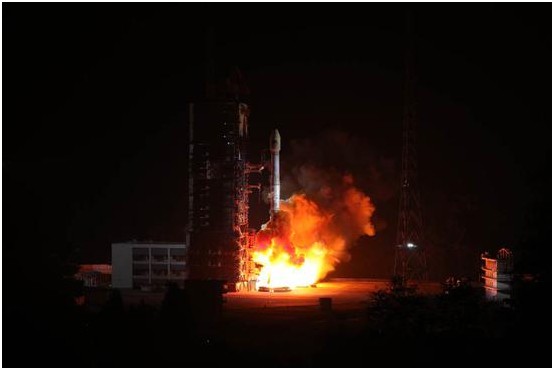Tel
+86 13145816559
2025-12-05
2025-11-25
2025-09-22
2024-01-22
2023-11-24
2023-01-06
2018-11-20 15:45:00
At 2:7 on November 19, China successfully launched the 42nd and 43rd Beidou navigation satellites with a Long March 3B carrier rocket at the Xichang Satellite Launch Center. The two satellites belong to the medium Earth orbit satellites and are the 18th and 19th networking satellites of the Beidou-3 system in China.

After more than three hours of flight, the satellite successfully entered the scheduled orbit, and will be followed by in-orbit tests and network coordination with 17 previously launched Beidou-3 navigation satellites.
The successful launch of this mission marks the successful completion of the deployment of China's Beidou 3 basic system constellation, and the subsequent system joint adjustment and performance index evaluation will be carried out, and it is planned to be put into operation by the end of the year, providing basic navigation services to "belt - road" countries and regions, and taking a "key step" for China's Beidou from the region to the world.
According to the China Satellite Navigation System Management Office, the Beidou-3 project was officially launched in 2009 with the approval of the state. The project completed the construction of the test system in 2016, and fully verified the new generation of navigation signal system, and implemented the network in accordance with the simplest system, the basic system and the global system. On November 5, 2017, the first network satellite launch mission was carried out at the Xichang Satellite Launch Center. At the end of March 2018, the simplest system consisting of eight Beidou navigation satellites was completed; At present, the construction of the project is progressing smoothly, and the basic system consisting of 19 Beidou navigation satellites will soon be put into operation. Subsequently, the Beidou Global Navigation Satellite System will be completed by the end of 2020, with global service capabilities.
Since November 2017, China's Beidou system network launch has entered a high-density period, with the united efforts of the whole project, in only one year, 11 Beidou navigation satellite launch missions have been successfully completed, and 19 Beidou 3 navigation satellites and 1 Beidou 2 navigation satellite have been successfully sent into the scheduled orbit. In particular, since July 2018, it has carried out 7 missions and launched 12 Beidou navigation satellites, with the shortest launch interval of only 17 days, creating a new record of high density and high success rate in the history of Beidou network launch.
Further news:
Talk to the chief designer of the Beidou navigation satellite system
Reporter: What is the significance and value of the two Beidou-3 satellites launched this time?
Yang Changfeng (Chief designer of the Beidou Navigation Satellite System) : The two satellites launched this time belong to the medium-circle Earth orbit satellites, which are the 18th and 19th networking satellites of the Beidou 3 system in China. After the satellite is launched into orbit, it will conduct in-orbit testing and test evaluation, and conduct networking coordination and performance index evaluation with the 17 Beidou-3 navigation satellites previously launched. It will be put into operation before the end of this year, providing basic navigation services to countries and regions along the Belt and Road. Since then, the deployment of the Beidou 3 basic system constellation will be successfully completed, and the "key step" from the region to the world will be taken. The BDS has become one of China's major achievements in the past 40 years of reform and opening-up.
Reporter: What is the basic system of Beidou-3?
Yang Changfeng: In 2009, with the approval of the state, the Beidou No. 3 project was officially launched. On November 5, 2017, the first Beidou-3 network satellite launch mission was carried out in Xichang Satellite Launch Center. At the end of March 2018, the deployment of the simplest system constellation consisting of eight Beidou navigation satellites was successfully completed. At present, the construction of the project is progressing smoothly, and the basic system composed of 19 Beidou navigation satellites will be put into operation soon after the launch.
Reporter: What is the performance of the Beidou-3?
Yang Changfeng: Beidou-3 not only increases its coverage to the whole world, but also achieves performance improvement and service expansion in the technical system, and the positioning accuracy is increased to 2.5 to 5 meters, which is 1 to 2 times higher than that of Beidou-2. In the transition process from Beidou 2 to Beidou 3, it can ensure that old users have no perception, new users improve performance, and finally realize the replacement of new and old technologies.
In terms of performance improvement:
One is a stronger "heart." The Beidou-3 satellite uses a higher-performance rubidium atomic clock and a hydrogen atom clock, with a stability of E-14 magnitude and a stability of E-15 magnitude for a hydrogen atom clock.
The second is newer technology. By adopting new technologies such as inter-satellite links, the Beidou-3 satellite's spatial signal accuracy can be better than 0.5 meters.
The third is better signals. The Beidou-3 satellite added the better performance of the interoperable signal B1C, while upgrading the B2I signal to the better performance of the B2a signal in the global system.
In terms of service development:
First, on the basis of further improving basic navigation service capabilities, space-based enhanced services will be provided in accordance with international civil aviation standards.
The second is to provide international search and rescue services in accordance with the standards of the International Search and Rescue Satellite Organization.
Third, on the basis of fully compatible Beidou 2 short message service, the service capacity is increased by 10 times, the transmission power of the user machine is reduced by 10 times, the short message service capability is greatly improved, and the user terminal is miniaturized and integrated, and the use is more convenient.